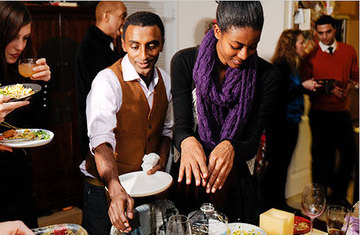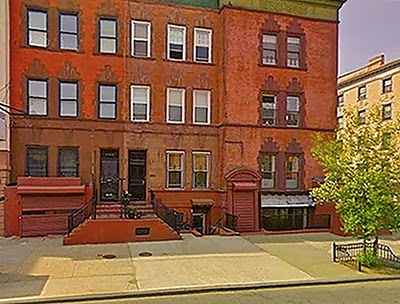
Tadias Magazine
By Tadias Staff
Updated: Wednesday, February 24, 2010
New York (TADIAS) – Red Rooster, the name celebrity chef Marcus Samuelson chose for his highly anticipated uptown eatery, restores to notice a legendary speakeasy from the Harlem Renaissance – an era when the neighborhood was buzzing with a new culture of artistic and literary expression coupled with jazz and glamorous nightlife.
“Yes, opening Red Rooster in Harlem later this year,” Samuelson confirmed via Twitter.
According to The New York Times, the new restaurant will be located near 125 street in downtown Harlem and the menu will feature traditional African American dishes among others.
But for Samuelson the motivation is more than food. “I always wanted to live in Harlem. Harlem was the community that I knew about when I was in Sweden. It was what I knew about America and African-American culture. I’ve always thought about Harlem. And I also think that if Harlem’s going to change then people like myself and others should stop talking about Harlem and move to Harlem. Harlem is not going to change because we talk about it. It’s going to change because we do something,” he said during an interviewing with Tadias Magazine following his White House appearance at the Obamas’ first State Dinner back in December.
“And I put my money in the economy. For me it’s not a PR stint. For me it’s a lifestyle. I sold my place and moved to Harlem to experience it. And I can’t write about an experience without having lived it. When I shop at C-Town, for example, it’s not because I’m happy to shop there, it’s because I want to have the same experience that the person who lives in this community has…”
As to the original Red Rooster, the Harlembespoke blog notes: “Since we weren’t around at the time of the legendary Harlem speakeasy establishments, hearing about The Red Rooster revival as a restaurant by Marcus Samuelsson had us digging for more information on the place. Some sources say that the little club on ACP/7th Avenue, at the southwest corner of 138th Street was around since the early 1900′s. The space that was one step down in the ground floor commercial storefront on the outskirts of the Striver’s Row nabe was apparently open until the 1980′s. Many folks in Harlem used to frequent the spot and among them, Adam Clayton Powell was a particularly well known patron. The (bottom) photo shows the corner of 138th Street at 2354 ACP/7th Avenue and the roll-down gated doorway to the far right would have been the entrance to the original The Red Rooster.”

Photo Credit: Harlembespoke
—
Join the conversation on Twitter and Facebook.


























Marcus,
Much love to you and your family!
Gigi
Dear Marcus,
Congratulation on your upcoming restaurant. I wish you good results and much success.
Good Luck.
Great choice of name. Red Rooster was a regular hangout and meeting place for many Harlemites of the day so it is a welcome news that Marcus Samuelsson, a resident of Harlem himself, has chosen to honor his neighbors with a piece of our storied history. Thank you and I wish the modern Red Rooster much, much success. WELCOME HOME!
We all proud of you, you are the son of Ethiopian.
Again keep up the goodwork.
I read about Samuelsson’s reopening a Red Rooster restaurant in Harlem. For a period of about six months from 1979 into 1980, I sang three and four nights a week at the original Red Rooster, working in a quintet with leader and trumpeter Bucky Thorpe; Don Pullen, who played Hammond B-3 on the gig but was best known for his years on piano with Charles Mingus; drummer Bobby Battle, who was also playing at that time with altoist Arthur Blythe; and guitarist Roland Prince from Antigua, who left to tour Europe with drummer Elvin Jones and was replaced by the late Ted Dunbar, teaching at Rutgers at the time. I was the only white face in the club most nights. It was a pivotal experience — the music was great, and I was able to stretch out on some of the tunes. Since several of the players had West Indian backgrounds, we would stray into a calypso or island-tinged original some of the time, but it was pretty straight ahead. The club was owned by Buster, a numbers banker putting his beautiful daughter/club manager, Pat, through law school at Yale. The crab cakes were excellent; I think the cook was from Baltimore.
There was Jock’s and another place across the street where organ duos or trios, including the likes of Jack McDuff and Charles Earland, would play. We would take our breaks and head next door for a listen, and vice versa.
By the way, I often took the subway to my gig, walking from the stop at 135th Street on St. Nicholas. I was perfectly safe although I was dressed up because they knew I worked for Buster. The gigs were long, five or six hours a night, and I would either get a gypsy cab home or Bucky and several of us would drive through Central Park in the moonlight. It was magical.
Up a block or so on the corner (139th?) and Adam Clayton Powell was a place that sold the best little sweet potato pies.
That was also the area of the Striver’s Row blocks. I was friends for a couple of years with the pianist John Hicks, whose three generations of family members shared one of those brownstones, which were designed by Stanford White. His dad was a very respected Methodist minister.
There were — and still are — other pockets of elegance in Harlem. Bucky, who was a retired postal employee, lived in a beautiful building on Riverside Drive with quite an amazing entryway. The band eventually dissolved because Bucky had diabetic complications. He had one leg amputated, but was still able to play with his stump propped on a bar stool. Then he got worse, and lost the other leg. We had several benefits for him. Somewhere I have tapes.
The “Harlem Renaissance” is one of the most important movements in history. Today a revolution has occurred but it took a while for it to come.
Chef Samuelson,
I wish you lots of luck on your new restaurant. I will be sure to stop by and enjoy some good food and music.